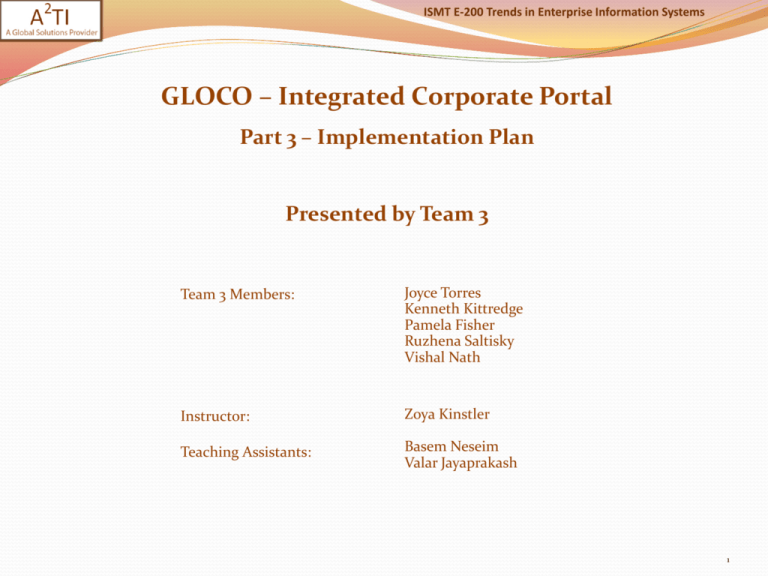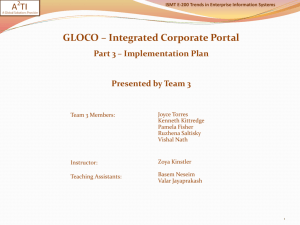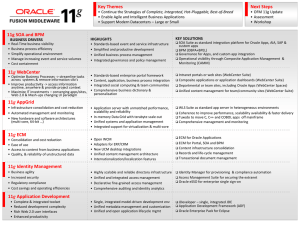ISMT E-200: Trends in Enterprise Information Systems
advertisement

ISMT E-200 Trends in Enterprise Information Systems GLOCO – Integrated Corporate Portal Part 3 – Implementation Plan Presented by Team 3 Team 3 Members: Joyce Torres Kenneth Kittredge Pamela Fisher Ruzhena Saltisky Vishal Nath Instructor: Zoya Kinstler Teaching Assistants: Basem Neseim Valar Jayaprakash 1 ISMT E-200 Trends in Enterprise Information Systems Problem Statement GLOCO’s acquisition of three other companies has resulted in an IT infrastructure that is maintaining four independent systems. There are duplicate applications and services. Employees currently must access multiple portals to perform their work. GLOCO needs to provide a single access point to reduce costs and improve employee productivity. The CIO requested an infrastructure improvement project RFP to address this issue. 2 ISMT E-200 Trends in Enterprise Information Systems Scope The implementation of the portal will include the following: Portal design and configuration to support each of GLOCOs major divisions. The portalization of GLOCO’s Travel Search application. The implementation of the Oracle WebCenter Suite email client and set up for all GLOCO users. Configuration of WebCenter Services. Configuration of WebCenter Spaces. The portalization of all GLOCO applications currently in use. The portalization of GLOCO’s Order Management System. Training materials designed for the end user community. 3 ISMT E-200 Trends in Enterprise Information Systems Not In Scope This project will not include: In-depth technical training for developers or support staff for Oracle WebCenter Suite 11g. The Purchase or installation of servers, load balancers, operating systems and miscellaneous associated software and hardware. Migration of databases from remote sites to GLOCO corporate headquarters. Support after the warranty period. Changes other than portalization to applications that will be incorporated into the portal. The portalization of applications not currently in use. 4 ISMT E-200 Trends in Enterprise Information Systems Training Training is available online. Adobe Captivate 5 - create WebCenter Suite demonstration modules Modules will cover many topics such as navigation, use of blogs, wiki’s, RSS, group spaces, search, collaboration tools, and how to customize screens Modules available online a month prior to cutover A help desk will be established when the modules are made Emails will keep employees informed of training and timeline for implementation Initial overview training - conducted onsite for programmers at corporate headquarters. 5 ISMT E-200 Trends in Enterprise Information Systems Training (cont.) Recommended courses for Administrators: Oracle WebLogic Server 11g Administration Essentials Oracle Directory Services 11g Essential Concepts (online) Oracle WebCenter Spaces 11g Build E2.0 Portals and Communities and Oracle WebCenter Spaces 11g Administration Recommended courses for Developers: Oracle WebCenter 11g Introduction to Portal Applications Introduction to Custom Applications Build E2.0 Portals and Communities 6 ISMT E-200 Trends in Enterprise Information Systems Stakeholders The following RACI Chart indicates the responsibility of each user group during deployment. The groups represent the GLOCO and A2TI teams. R esponsible A ccountable C onsulted I nformed Project Manager Technical Lead Manager Development Lead Training Lead Support Lead Project Sponsor WebCenter Installation I R A I I A Training A C C R I I Portal Development A C R I C I Deployment A R C I C I Support I C C I R I Warranty I C C I R I 7 ISMT E-200 Trends in Enterprise Information Systems Operational Considerations Support is the responsibility of the GLOCO IT Operations department. Development support will remain with the existing development teams. Enhancement requests and incidents will be submitted to the GLOCO internal ticketing system. Emergency fixes will be prioritized by the affected development and business leadership. Tickets are opened either by going online or by sending an email to itoperations-requests@gloco.com. 8 ISMT E-200 Trends in Enterprise Information Systems Deployment Install WebCenter & SetUp Portals • Portalize Applications • Move all Applications to the Corporate Application Farm • Set Up User Email • Set Up Divisional Portals Training • Provide Training to End Users • Provide Training to Support Staff • Support Staff Complete Oracle University Training Pilot Deployment • Pilot Groups from Each Division • Defects Reported to GLOCO Help Desk • A2TI Responds to Defects Full Deployment • Defects Reported to GLOCO Help Desk • A2TI and GLOCO Respond to Defects Warranty Period • Defects Reported to GLOCO Help Desk • A2TI and GLOCO Respond to Defects 9 ISMT E-200 Trends in Enterprise Information Systems Risk and Mitigation The owners of legacy applications may have a difficult time accepting the perceived loss of their applications Mitigation: The applications need to be manage by the same group that managed them before. A service level agreement should be signed between the application owners and GLOCO corporate. Managing change is a crucial part of any transition Mitigation: A training program on portal use will be instituted prior to, during, and after implementation to ease the users transition. 10 ISMT E-200 Trends in Enterprise Information Systems Risk and Mitigation (cont.) Delay in the response from the applications via WebCenter Mitigation: Move applications and databases into corporate datacenter. And, use ajax (or similar technologies) in application development. Security on the portal is a major concern. Mitigation: Implement WebCenter’s robust security model. Delays by either GLOCO or A2TI could affect the timeline. Mitigation: Weekly meetings will enable the team to monitor progress and communicate concerns. 11 ISMT E-200 Trends in Enterprise Information Systems Success Metrics The introduction of the portal will provide measurable benefits to GLOCO. Applications will see a 100% adoption rate in the first year if they remove all other access to their applications. Measurement: WebCenter Analytics enable us to determine portal adoption, application use, and collaboration rates by tracking user visits to each page. Support cost will decrease by 60% after the first year The cost to maintain an application will be measured by determining the number of applications being supported one year after implementation and the total support costs before and after implementation. 12 Questions? 13





